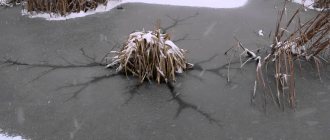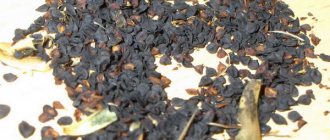Choosing a location and preparation details
The initial stage of work includes choosing the location of the future structure, creating a project, as well as purchasing the necessary materials and tools.
In this type of work, a drawing is not at all necessary; the structure can be built, as they say, by eye. But if you are planning a more massive structure with several levels or want to implement an original design move, then it is better to draw up at least a minimal project in advance. This will help you better understand what exactly you want to see on your site, as well as avoid errors during construction work.
For the pond, it is recommended to find a flat, drained, dry surface without defects. It is advisable to place the pond in the shade. If it will be located in the sun, it is better to plant several green spaces nearby to shade the structure. If you are studying the art of Feng Shui, it is recommended to place the pond in the east or south of the site.
You can make a similar pond yourself
Before construction you need to take the following materials:
- old bath;
- crushed stone;
- pebbles;
- brick;
- natural or artificial stone;
- sand;
- clay;
- cement;
- glue;
- dye or color film.
Don’t forget about the material that we will need.
You should also have the following tools in your arsenal:
- hammer;
- container for solution;
- shovel;
- sheet of tin or pan;
- metal mesh;
- level;
- gloves.
Step-by-step creation of a pond: getting started
After determining the area in which the artificial reservoir will be located, you can begin its arrangement. This work involves several steps. It is not recommended to deviate from the instructions, as this may lead to an unsatisfactory final result.
The first stage of arranging a small pond on the site is marking. It is necessary to designate the perimeter of the future reservoir. Wooden stakes and rope are used for this. It is worth noting that the dimensions of the pit must exceed the size of the cast iron container by approximately 10 cm. This is necessary in order to place the material that will serve as drainage.
At the next stage, you can start digging a hole. Its depth should exceed the height of the cast iron bowl by 20 cm. This reserve is also necessary for placing drainage material at the bottom of the recess. The bottom must be level. To do this, it is worth checking it with a building level.
Technological process
Sequence of work
To build a pond yourself from an old bathtub, you must follow a series of sequential steps:
- The bath needs to be prepared. To do this, cement the drain and wait until the solution dries.
- We give the surface of the bathtub the appearance of a natural bottom: cover the inside with a colored film, treat it with adhesive or paint it in soft colors. Beige, black, gray will do. You can also take soft blue or green - they will give the water a special shade. To prepare the adhesive composition, mix the ceramic tile adhesive with water and dye in the proportions specified in the instructions to a dough-like mass that will quickly harden. When doing this work, you must wear gloves.
- After treatment, let the bath dry for several days, before covering it with a film protecting it from precipitation.
- While drying, you can start digging a hole. Place the container on the intended area and mark the boundaries - drive stakes around it and tie it. After marking, start digging a hole the size of the bathtub. In this case, fix the sides of the bathtub 20–25 cm below the ground level when immersed in the hole.
- Dig another hole in the main hole to secure the drainage.
- We do drainage. Roll up a sheet of tin or take a pan with a hole in the bottom and place it in the recess. Then fill it with crushed stone so that the layer protrudes 15–20 cm above the level of the bottom of the main recess.
- Cover the bottom with crushed stone and make a sand cushion. In total, the laid covering should be 15–20 cm.
- Compact the raw materials and remove the container placed in a small recess, working carefully and without haste.
- Secure bricks at the corners of the pit.
- Grasp the container into the hole. It is recommended that you take the winch and work with a partner to avoid injury and damage to materials.
- When submerged, the bathtub drain must coincide with the location of the drainage.
- Using a level, check that the upper edges of the future pond are installed correctly and are symmetrical.
- Pour sand along the edges of the top side, moisten it with water and compact it firmly.
- Place the net along the edges of the future pond in a continuous layer or in four parts. Apply cement mortar and place small stones to stiffen it. After completion, wait for the solution to dry.
- Cover the bottom with clay, dilute with water and coat the surface tightly with a layer of 5–7 cm. This way the root system of the plants will take root well.
- Dig a trench around the pond, lay a net in it and lubricate it with the solution so that there remains a small ditch of 30–40 cm for green spaces.
- For decoration purposes, place stones, pebbles or other material around the pond so that the edges of the bath are covered and secure with mortar.
- Start pouring water. It is better to do this with a garden hose - the flow should flow in a thin stream. At the same time, watch the soil - it should not erode. It is allowed not to change the water completely, only to add it periodically, and the water overflowing the banks will simply be absorbed into the ground. Draining and cleaning of the reservoir will be required only if there is uncontrolled reproduction of organisms or the development of viruses.
- After this, you can begin the landscaping stage.
Pond from an old sunken bathtub
The location has been chosen, now let's get to work. You will need the following tools and materials:
- old cast iron bathtub;
- crushed stone, pebbles, facing stones and bricks;
- cement, sand and clay; wheelbarrow;
- container for mixing the solution;
- Master OK;
- shovel;
- tin sheet;
- waterproof glue;
- roulette;
- level;
- paint or film.
Arrangement of a reservoir at the dacha with your own hands begins with the preparation of the most important participant in the program - with a bath. Cement the side drain. If desired, the surface of the bathtub can be made of a more natural color - paint it in any natural tone from a mixture of tile adhesive and pigment, or, if you want to imitate the color of sea water, lay a film of the corresponding color.
Stages of building a pond from a bathtub
Now we are preparing a place for the foundation pit. Make a mark on the ground and dig a hole 25 cm deeper than the height of the bathtub. Dig another hole under where the drain will be located. This pit should have dimensions of 60x60 cm. Insert a rolled sheet of tin into it so that it is 25 cm higher than the level of the main pit. Fill the small hole with gravel up to the edges of the sheet and remove it after filling the sand bed. The sand layer should be 25 cm. It's time to install the bath. When installing, make sure that the location of the water drain corresponds to the location of the small hole. Add wet sand into the void between the walls of the bathtub and the bowl of the pit. At the same time, you can fill in water according to the level of the sand being poured. The earth will settle, and if you plan to add plants to your mini-pond, drain the water through the drain hole and prepare everything for the future inhabitants of your pond.
Bath pond in practice (video)
Other decorations
Decorative additions will highlight the pond favorably and give it greater aesthetics. To decorate the pond and make it more natural, you can place small or dwarf water lilies, lilies, or even add duckweed on the surface of the water.
Plus, you can easily create a natural asymmetry of the reservoir by changing the width and height of the banks. This is done in several ways:
- formation of a mini-beach from crushed stone on one side of the pond;
- placement of an alpine mound or mixborder.
Read also: a guide on how to create an alpine slide.
In addition, you can install a small fountain made of a clay jug, place some figurine figurines, or create a hard floor around the pond so that children can sit or play comfortably. Later, introduce small fish into the water. Verkhovkas are well suited for an improvised pond.
It is not recommended to introduce snails and crucian carp into a pond, since the former reproduce in excessive quantities and completely clean the bottom, while the latter will make the water cloudy due to the fact that they prefer to stir in the ground.
Recommendations for correct operation
The created small pond will decorate the site, but despite its tiny size, it still requires good care.
- Due to evaporation, periodic addition of water is necessary. In this case, it is better to overflow, since the excess liquid will still be absorbed into the soil.
- There is no need to constantly change the water in it. Such an operation is necessary if there is a need to clean it of various deposits when “persona non grata” have appeared in the pond - aggressive plant species, crawling “crooks” who have decided to stay.
- To prevent the water in the pond from acquiring an unpleasant odor, 2 buckets of water taken from a natural reservoir are poured into the bath. The microorganisms in it feed on algae, which is the cause of this unpleasant phenomenon - flowering.
- Snails in a pond with plants and fish are unwelcome guests. A greatly expanded family will become a great threat to vegetation, and therefore to the diet of underwater inhabitants. They can even spoil (eat) the artificial surface of a reservoir.
- Such a pond will not make a real aquarium, because it is impossible to keep the water crystal clear in it; it will become cloudy within a few days. For this reason, very delicate creatures, accustomed to ideal conditions, simply will not survive there.
Artificial pond in winter
Before the onset of winter, the water from the pond is usually drained, the “living creatures” and plants are put away for the winter in a warm place. The walls of the reservoir are thoroughly cleaned and washed. The dry bath is covered with a sheet of iron, tarpaulin or roofing felt. The latter materials are fixed with stones or bricks. However, draining the water is an operation that is not considered mandatory.
To prevent destruction of the walls of a cast-iron bathtub filled with water, a thick layer of snow should always remain on the surface of the ice. It will protect the water from freezing. Another way to protect the vessel is to place a half-empty plastic container in the water. It is half filled with sand. These bottles will serve as a kind of improvised damper if the water suddenly starts to freeze.
Making a cute bathtub pond is pretty easy. Its construction does not require expensive materials or special tools, and the work, if you have a cast iron container and a great desire to “create something like that,” can be done in a few days. If you still have any questions, then perhaps they will be answered in this video:
Features of the construction of a multi-level pond
The construction of a pond with several levels requires the presence of several water containers; one bath will not be enough. You can make a cascade-shaped pond, for which you will need to place one bath a level higher than the other and run a gutter between them. This gutter can be of a simple shape, for example, a straight stream or waterfall, or it can be winding, but such a design will be more difficult to implement.
When building a multi-level pond, you will need all the same materials as with a conventional structure, but their quantities will differ. As we have already said, you will need another container and material for the gutter; you can take a plastic pipe.
Transformation of a bathtub into a pond
You will need:
- container for mixing cement;
- bucket;
- scoop or trowel;
- wire pliers;
- scissors for cutting mesh;
- glue used to glue tiles.
Work progress:
- Dilute the cement-based adhesive with water according to the instructions. If your glue is white, you need to add a dark pigment to it. The result should be a mixture with a dough-like consistency. Please note that it turns to stone very quickly, so work must be carried out without distraction.
- Wear gloves and manually apply glue to the entire surface of the bathtub, first on the walls, and then what remains - on the bottom. You don’t have to worry too much about the glue spreading in uneven layers, it will even be better. All actions can be performed either while at the bottom of the container or lying on the soil near it. You can spread glue on the surface before lowering the bathtub into the pit, but then there is a possibility of damage to the surface. The point of the whole procedure is to make the bath a natural earthy color, and look more like a natural pond. Alternatively, instead of glue, you can use a cement solution, but this work is more difficult, since the mixture will flow down the walls.
- Now you need to lay the mesh. You can take a solid piece, or you can take small pieces. It depends on the shape of the mesh. It needs to cover the top edge and walls to the middle of the container.
- At the corners of the bathtub, tie wire rings perpendicular to the wall; in the future, shelves will be attached to them.
- Pour dry clay onto the bottom of the bath, layer thickness - 3 cm.
- Dilute the clay with water to make a thick paste and coat the walls of the bath with it.
- Plant moisture-loving and not very demanding plants, such as mint or coltsfoot, in the clay at the top of the wall of the future pond.
- Wait a few hours until the clay dries and you can fill the bath with water. Water should be released in a thin stream from a hose; you can put on a spray nozzle, placing it on the bottom so as not to destroy the clay layer.
- In the ditch that runs along the perimeter of the reservoir, you need to place marsh plants that love moisture, and put stones that will create the feeling of banks. When water is added to the pond, some of it always overflows and moistens these plants.











